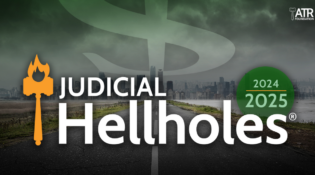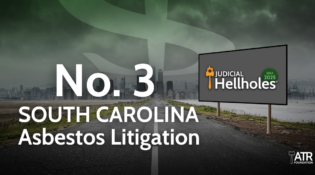The 2022-2023 Judicial Hellholes® report shines its brightest spotlight on eight jurisdictions that have earned reputations as Judicial Hellholes®. Some are known for allowing innovative lawsuits to proceed or for welcoming litigation tourism, and in all of them state leadership seems eager to expand civil liability at every given opportunity.

2022-2023 Executive Summary

2022-2023 Judicial Hellhole Report
Every year we shine a light on the worst of the worst. The report shines its brightest spotlight on jurisdictions, courts or legislatures that have earned reputations as Judicial Hellholes®.
download reportJUDICIAL HELLHOLES SUMMARIES
#1 GEORGIA Nuclear verdicts are bogging down business and third-party litigation financing is playing an increasing role in litigation. The Georgia Supreme Court issued several liability expanding decisions in 2022 and placed the onus for reform on the Georgia legislature.
#2 THE SUPREME COURT OF PENNSYLVANIA & THE PHILADELPHIA COURT OF COMMON PLEAS The Pennsylvania Supreme Court continues to pro- mote forum shopping and eliminated an important rule governing where lawyers may file medical liability cases. The Court also opened the door to awarding plaintiffs unreasonable attorneys’ fees. The Philadelphia Court of Common Pleas continues to be a preferred court for mass tort litigation. This court also hosts most of the state’s nuclear verdicts. Plaintiffs from across the country flock to the Court of Common Pleas because of its reputation for excessive verdicts and its “open door” policy to out-of-state plaintiffs.
#3 CALIFORNIA Baseless Prop-65 lawsuits thrive in courts and the volume of litigation continues to skyrocket. Small businesses are weighed down by frivolous Private Attorney General Act (PAGA) and Americans with Disability Act (ADA) accessibility lawsuits. The state’s unique lemon law provides windfalls for plaintiffs’ lawyers. California also is at the forefront of the climate change litigation battle and a state court permitted a novel theory of COVID-19 liability to proceed.
#4 NEW YORK California and New York battle it out for the most “no-injury” consumer class action lawsuits and the most claims under the ADA. New York also continues to see a surging number of nuclear verdicts driven in part by the allowance of “anchoring.” The state has adopted an open-door policy for predatory lawsuit loans and the litigation climate contributes to the state being one of the worst for doctors.
#5 COOK COUNTY, ILLINOIS Illinois, especially Cook County, is a magnet for “no-injury” lawsuits stemming from the state’s Biometric Information Privacy Act (BIPA) and consumer class actions. Additionally, an overwhelming percent of the state’s nuclear verdicts come out of the Cook County trial court.
#6 SOUTH CAROLINA ASBESTOS LITIGATION South Carolina’s consolidated docket for the state’s asbestos litigation has developed a reputation for extraordinary pro-plaintiff rulings. A Texas law firm has its way in court and appellate courts bolster outlier rulings. As a result, the state has become a hot spot for asbestos claims.
#7 LOUISIANA Coastal litigation continues to drain state resources. Judicial misconduct appears to run rampant across the state and the investigation continues into a massive scheme to defraud commercial truckers and insurers in Louisiana courts. A state court also opened the floodgates to COVID-19 litigation not permitted elsewhere.
#8 ST. LOUIS St. Louis once again finds itself on the list; however, the “Show-Me-Your-Lawsuit” state has made important progress through legislative reforms. While the legislature has prioritized civil justice reform, there is more work to be done. Junk science is permitted in St. Louis courts, which have a history of nuclear verdicts. Courts allow “phantom damages” and it’s a favorite jurisdiction for asbestos litigation.
WATCH LIST
Beyond the Judicial Hellholes®, this report calls attention to three additional jurisdictions that bear watching due to their histories of abusive litigation or troubling developments. These jurisdictions may be moving closer to or further away from a designation as a Judicial Hellhole® and they are ranked accordingly.
FLORIDA LEGISLATURE Despite all the work done by the Florida Supreme Court and Governor Ron DeSantis to mitigate lawsuit abuse, much-needed reforms continue to stall in the Florida Legislature. The legislature needs to address issues including inflated medical damages and deceptive trial lawyer advertising and take additional action to respond to the state’s property insurance crisis.
NEW JERSEY reappears on the Watch List due to a variety of factors that could lead to the “perfect storm” of litigation abuse across the state. The trial bar has achieved the triple threat – they wield unprecedented power in the state legislature, the Governor has no real interest in civil justice reform, and the new makeup of the New Jersey Supreme Court may result in a shift toward activism and expansion of liability.
TEXAS’S COURT OF APPEALS FOR THE FIFTH DISTRICT repeatedly misapplies established U.S. Supreme Court and state precedents and procedures, requiring review and reversal by the state’s high court. It has developed a reputation for being pro-plaintiff and pro-liability expansion.
DISHONORABLE MENTIONS
Dishonorable Mentions comprise singularly unsound court decisions, abusive practices, legislation, or other actions that erode the fairness of a state’s civil justice system and are not otherwise detailed in other sections of the report.
Included among this year’s list is the American Law Institute’s adoption of a controversial restatement, Madison and St. Clair Counties – the plaintiffs’ lawyers preferred jurisdictions for asbestos litigation, the Montana Supreme Court’s refusal to apply a statutory cap on damages, and a Wisconsin appellate panel decision to affirm a judgment despite unreliable expert testimony.
POINTS OF LIGHT
This year’s report again enthusiastically emphasizes the good news from some of the Judicial Hellholes® states and other jurisdictions across the country. Points of Light are examples of fair and balanced judicial decisions that adhere to the rule of law and positive legislative reforms.
Among the positive developments, the Florida Supreme Court issued a pair of well-balanced commonsense decisions, the U.S. Court of Appeals for the Fourth Circuit upheld a West Virginia law regulating deceptive advertisements, the Arizona Supreme Court required a heightened standard for punitive damages, and Maryland’s highest court rejected the “loss of chance” doctrine.
In addition to court actions, nine state legislatures enacted significant, positive civil justice reforms in 2022, including an Arizona bill to prevent over-naming of defendants in asbestos litigation, Florida legislation to address the property insurance crisis, and Kansas and Louisiana bills that regulated misleading and deceptive trial lawyer advertising.
CLOSER LOOKS
THE MASS TORT MACHINE Mass tort litigation has become a multi-billion-dollar industry for plaintiffs’ lawyers as they target manufacturers of everything from pharmaceuticals and medical devices to herbicides and military-grade ear plugs. Regardless of the product, the trial bar’s playbook is essentially the same every time. They spend millions of dollars on advertising in plaintiff-friendly Judicial Hellholes® in search of potential claimants. Plaintiffs’ lawyers rely on traditional and social media to bolster litigation, often pushing inaccurate and baseless claims in friendly outlets. Lawyers then partner with so-called experts to provide misleading scientific evidence to support their claims both inside and outside the courtroom. These activities are mostly funded by third-party investors who invest the necessary money up front to initiate these tactics. The goal is to overwhelm the courts with a flood of questionable litigation and pressure the defendant to settle even meritless cases.
THE NATIONAL ASSOCIATION OF ATTORNEYS GENERAL – FOR THE PEOPLE OR FOR THE PROFIT? When the National Association of Attorneys General was founded in 1907, its goal was to support the top law enforcement officer in each state in fulfilling the sworn oaths each took to serve the people of their state. The organization claims to be a “nonpartisan national forum providing collaboration, insight, and expertise to empower and champion America’s attorneys general.” But over time, NAAG’s focus has shifted from promoting collaboration to promoting entrepreneurial litigation. NAAG has primarily turned into an organization that has only one goal: suing businesses for profit.
Latest News

SOUTH CAROLINA SUPREME COURT FAILS TO REIN IN JUDICIAL HELLHOLES® JUDGE
In a disappointing decision, the South Carolina Supreme Court upheld Judge Jean Toal’s appointment of a receiver over a Canadian
Judicial Hellholes
NEW JERSEY DISTRICT COURT HAS OPPORTUNITY TO REIN IN THE USE OF JUNK SCIENCE IN TALC LITIGATION
Today, April 29, 2025, Pecos River Talc LLC, a successor to LTL Management, LLC, a subsidiary of Johnson & Johnson,
Judicial Hellholes
Governor of ‘Judicial Hellhole’ State Stresses Vital Importance of Addressing Lawsuit Abuse
Today, South Carolina Governor Henry McMaster held a press conference to emphasize the importance of addressing the issues plaguing the
Points of Light
